Wagons and Carriages
What do these photos tell you about the different kinds of wagons and carriages
farmers and ranchers used?
One Horse Carriage
This photo shows a woman driving a light carriage pulled by one horse.
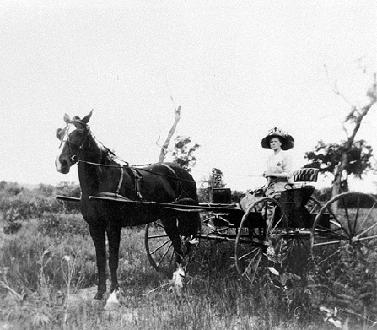
Photo: Colorado Historical Society
More About This Topic
Most people in Colorado in the 1800s traveled by horse-drawn carriages and wagons. Small carriages like this one needed only one horse. Its leaf springs made of steel helped make the ride a comfortable one. Can you find the leaf springs?
Their Own Words
“We didn’t have a car at that time, and we lived on what was called the Hughes Ranch, and there were lots of horses. I drove this buggy, and sometimes I would drive our old horse and the buggy, and at other times Mr. Saunders would put up the horses—I would use one of his. His old horse was called Flaxie, and she was very, very hyper, as we say today. And oh, she was a problem. To get Flaxie into the shafts at the end of the day, and hitched up, and get those four children loaded in—I took the four, because I took my little half-sister and half-brother, Ada and Joe, and . . . I picked up Cora and Gretchen [Saunders].”
Source: Catharine Craig Coles quoted in Julie Jones-Eddy, ed. Homesteading Women: An Oral History of Colorado, 1890-1950, (New York: Twayne, 1992): 190-91.
Two Horse Carriage
This photo was taken at a livery stable in Trinidad, Colorado. It shows four people riding in a two-horse carriage.
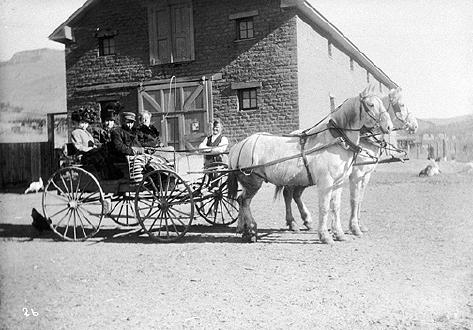
Photo: Colorado Historical Society
More About This Topic
Larger carriages like this one could carry four or more people. It took two-horses to pull this carriage. Livery stables like the one in this photo rented horses and carriages by the day or week. Many people who lived in towns could not afford to buy a carriage or keep and feed a horse. They rented a carriage when they needed it.
Their Own Words
“Another driving team [of horses] that I only heard tell about was a pair of wild pinto ponies. They were hitched to a spring wagon, a vehicle that served the same purpose as the pickup truck.”
Source: Hazel Webb Dalziel, “The Way It Was,” Colorado Magazine, 45 (Spring 1968): 106.
Wagons For Wheat (1904)
This is a photo of a wheat threshing operation on a farm. The farm was probably near Denver. One man is operating a tractor. The belts from the tractor supplied power for the threshing machine.
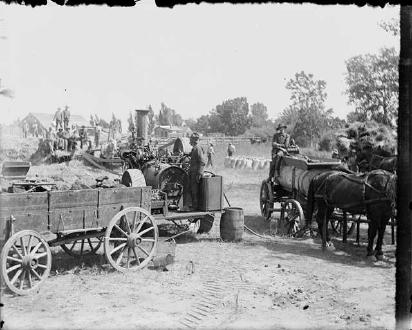
Photo: Denver Public Library, Western History Collection
More About This Topic
Parked near the tractor are two different kinds of wagons. One of these wagons appears to be carrying spare parts. The other is a water wagon. The photo was taken about 1904.
Their Own Words
”The threshing crew went from farm to farm with a well-worked-out itinerary. . . . The cook house [wagon] came first—a long narrow house built on wheels, with strips of screening covered with canvas curtains along each side which could be raised or lowered, and doors at both ends with removable steps for easy access. Under the windows were long wooden tables and benches where the crew had their meals. . . . After the cookhouse arrived . . . the water wagon would pull in and then we’d hear a whistle and the steam engine drawing the separator would come puffing up the road.”
Source: Hazel Webb Dalziel, “The Way It Was,” Colorado Magazine, 45 (Spring 1968): 108-109.
A Covered Wagon
This farm wagon had a canvas cover. Covered wagons were most often used for long-distance travel.
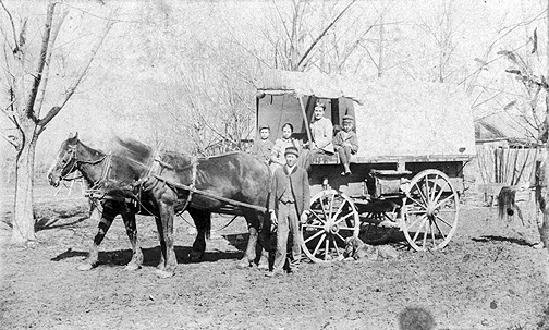
Photo: Colorado Historical Society
More About This Topic
Most covered wagons were ordinary farm wagons. They were fitted with half-circle hoops that held up the canvas cover. Families often used covered wagons to move west.. Moving by wagon was less expensive than traveling and shipping household goods by train.
Their Own Words
"You could still get homesteads in Colorado [in 1918]. . . . We came in a covered wagon drawn by two flea-bitten gray horses. . . . We had a tent and a wagon, because there were four of us, and on the wagon . . . there was a water bag, which was made of canvas and hung outside where the air cooled the water and kept it cooled, because it was a little ways between towns. . . . There was a box on the back of the wagon that was called a grub box where the food was carried. My mother and I slept in the wagon, and my dad and my brother slept under the wagon or in a tent. . . . So that's the way we got along. It took us about three months to get to Colorado [from Texas]."
Source: Jarrine Sylvia Crosslen quoted in Maria M. Rogers, ed., In Other Words: Oral Histories of the Colorado Frontier (Golden, CO: Fulcrum Publishing, 1996): 9.
A Stage Coach
This is a stagecoach pulled by three teams of horses.

Photo: Colorado Historical Society
More About This Topic
People used stagecoaches when they had to travel long distances in a hurry. The coaches stopped at stagecoach stations every ten miles or so to hitch up fresh horses. Stagecoach travel was very expensive.
Their Own Words
"The [stagecoach] line was called the Ferguson Stage Company and the [coaches came] to Lamar from Dodge City, Kansas. [The coaches] consisted of hacks or light spring wagons with tops and seats, the sets running crosswise of the wagon. They were drawn by four horses. . . . Mr. Silver [her father] and Mr. Ferguson had barns at both ends and made a trip each way every day, carrying passengers and the mail. They also made special trips to other towns in that section of the country…."
Source: Josephine Silver (1934), CWA Interviews, Doc. 355/34, Colorado Historical Society.
Unloading Suage Beets Wagons
This photo shows men using pitchforks to unload sugar beets from a a horse-drawn wagon and from the back of a truck. You can also see horse teams in the tilled field in the background.
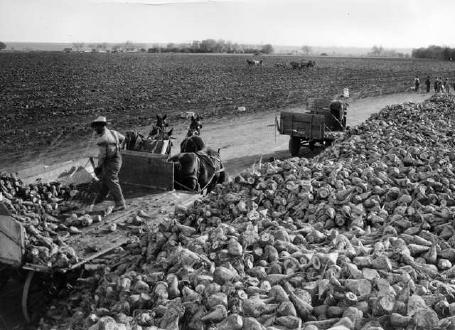
Photo: Denver Public Library, Western History Collection
More About This Topic
This photo was taken in about 1920, when both wagons and trucks were in use side-by-side. Still, a lot of the work in producing sugar beets was done by hand labor. Machinery for working sugar beets was not yet very wide spread.
Their Own Words
“[The Mexicans] came in and worked the crops and hoed the beets. They used to top those beets by hand; they hoed those beets by hand. Those fields would have twenty-five or thirty men, women, and kids out there. As soon as they was big enough to swing a hoe they were out there hoein’ those weeds out of the beet fields. They didn’t have cultivators and that stuff like they do now. They didn’t have farm machinery. It was all done by hand.”
Source: Jack Rowley quoted in Maria M. Rogers, ed., In Other Words: Oral Histories of the Colorado Frontier (Golden, CO: Fulcrum Publishing, 1996): 12.
A Blacksmith Shop
This is a photo of a blacksmith shop somewhere near Denver, Colorado. You can see a number of different kinds of horse-drawn, buckboards, and carriages in front of the shop. Signs on the shop's walls say "Wagon and Carriage Shop" and "N.C. Thomson's Farm Machinery."
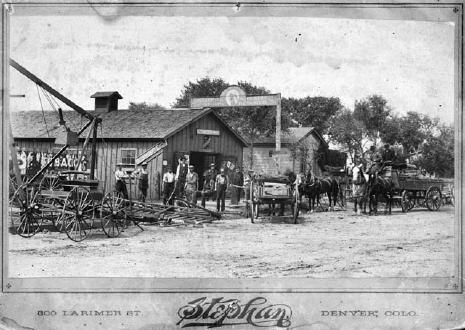
Photo: Denver Public Library, Western History Collection
More About This Topic
While wagons and carriages were probably more reliable than early automobiles, they still needed to be repaired from time to time. That was a job for the blacksmith.
Their Own Words
“I used to spend quite a lot of my leisure time at the town blacksmith shop. The shop seemed always to be busy, shoeing horses, mostly during the summer, and repairing wagons, hay mowers, etc., during the winter when horseshoeing was slack. I was always fascinated by the blacksmithing, watching the operations of forging and fitting of the horseshoes, and watching the sparks fly from the various welding jobs. The blacksmith shop was owned and operated by a German whose name was Jacob Weiss. He always had a hired man as helper, and at one time they made several new wagons. Two or three were ore wagons, extra heavy, much heavier than the ranch wagons. They were nice looking wagons, too, after being painted.”
Source: George W. Champion, “Remembrances of South Park,” Colorado Magazine, 40 (January 1963): 24-25.

